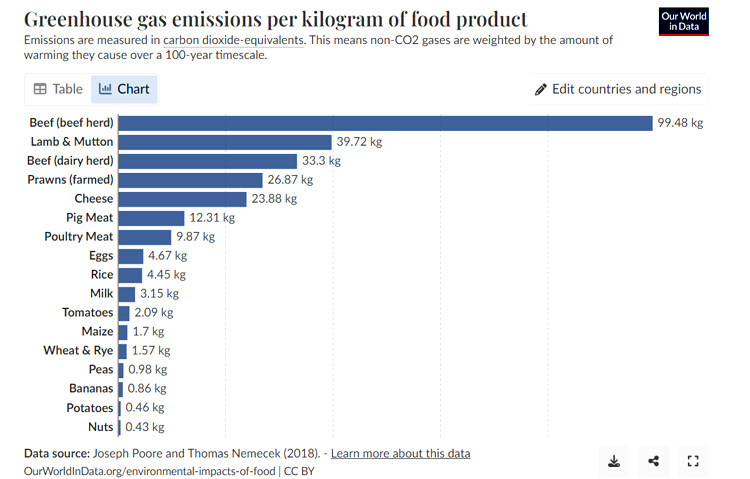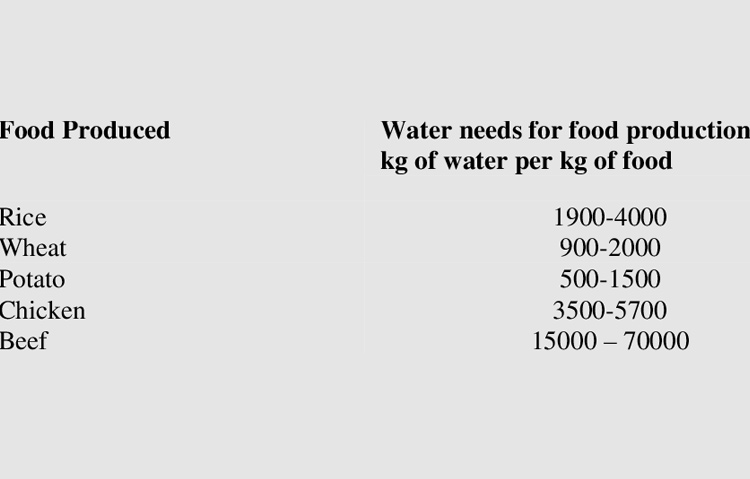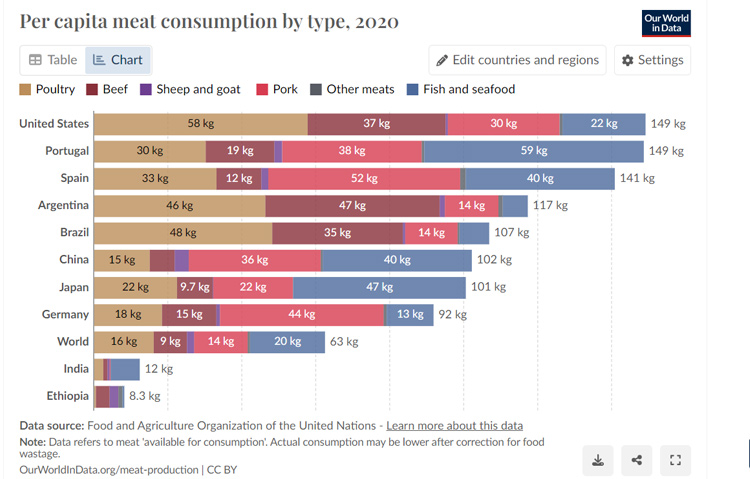- Beef production releases more Green house gas emissions and consumes more water. Which country is the biggest consumer of beef? What are substitutes for beef? Please read and decide for yourself, what is good for the world.
The Daily news headlines of raging Forest
Fires, flooding, El Nino, Melting Glaciers, scathing cyclones, excessive rain
in short spells and perennial droughts, should seriously startle and awaken us
to a future reality of a baked earth, and parched lands. Our very own survival
is at threat.
But did you ever sit to think that our culinary choices are partially to blame?
At the outset I must state that this article is not about dictating your eating habits. It is about food choices that we unknowingly make – which can have a seriously adverse effect on global climate. It does not call for a ban on any food, but making our choices keeping in mind the global climate.
When you go to USA or Australia and
decide to indulge in a McBurger or relish the stakes served at a Bar-B-Que
party, you are unwittingly contributing to the Climate Change, as we hurtle
down the road to extinction.
So, what’s “beef” got to do with all this? The answer is far more complex then we realize. Here is some food for thought:
The fundamental cause of global warming is “Greenhouse gas” (GHGs) emissions of Carbon dioxide and other noxious gases which surround the earth and trap the sun’s heat leading to Climate Change.
Typically, we associate global warming with the Transport and manufacturing industries which are big consumers of fossil fuels such as Oil, Gas and Coal. Whilst the world focuses primarily on developing cleaner, renewable sources of energy, I believe we are missing the Elephant in the room. The elephant in this case is “beef” - cattle meat of cows. In India beef is invariably meant buffalo meat.
As per various studies, Agriculture and Livestock farming contributes anywhere from 15 to 20 % of the total GHG emissions. A further breakup of the GHG’s emissions of food products is given below:

Source
Ourworldindata.org Simply put, the amount of
carbon-dioxide equivalent released in the atmosphere is a staggering 99.48 Kgs
per kg of beef (beef herd) that is approximately 50 times more than most
vegetarian food items. Other meats are less polluting than beef, but still have
substantially higher emissions than vegetarian diets.
Why does Beef generate such
high Greenhouse Gas Emissions?
Cows release not just Carbon Dioxide (CO2)
but Methane and Nitrous Oxide. Methane is generated in the process of digesting grasses and plants, in the form of “burps” and manure. Unfortunately, Methane has a “Global Warming Potential” 28-34 times that of CO2.
Similarly, Nitrous Oxide, another powerful GHG, emitted from ruminant wastes and chemical fertilizers used for Animal Feed has a “Global Warming Potential” of 265 times that of CO2.
Beef also requires sizeable
quantities of pasture land. As the land on the planet is finite, forests are hacked to create more pasture. Visiting Switzerland, you marvel at the fat, healthy cows grazing on lush green pastures. It’s a pretty picture, but only suitable for chocolate wrappers. The environmental damaged is disguised.
How much Water is needed
to produce food?
It is not just about Emissions… A related aspect is the water consumed for the production of food. If you thought that water is required only to grow crops, you are completely mistaken.
A cow eats several hundred kgs of grass,
corn and other grains during its lifetime. Water is necessary to grow that
diet. Similarly, after a cow is slaughtered it takes hundreds of litres of
water to clean the carcass and extract the meat.
The truth is growing Crops and
vegetables consume way less water as compared to production of Chicken or Beef.

Source
Researchgate.net Even if you consider a lower estimate of
20,000 litres of water per kg of Beef, that much water is enough to sustain a
family of four with drinking water for 2000 days.
If limited potable water resources are
prioritized for growing cattle feed and washing the meat and carcasses of dead
animals, it needs a serious re-think.
An industry veteran says, “Beef rearing is indeed a environmentally damaging food for two reasons. 1. For the gas emissions by animals is very high. 2. Very large tracks of land grow grain which is fed to animals such that about 8 kgs turns into one kg of meat. This consumes a lot of water. That is why chicken is most efficient where just 1.5 kgs turn into 1 kg in meat.”
Let us look at the Meat Consumption of
various countries
Which Countries consume
the most beef per Capita?

Source Ourworldindata.org
The largest consumer of Meat in the World by per capita is USA – consuming atleast 12 times more meat, and 32 times more beef, per capita as compared to India. This is not surprising since 100% Beef Super Macs have been the staple diet of most Americans for generations. Other large meat consumers are mostly in Europe, Australia and South America.
However, we also need to study the trend of consumption. Beef consumption is stagnating in the West while it is on an increasing trajectory in India. In our global village, cultures, habits and lifestyles get blurred, resulting in an increasing trend of younger Indians aping Western habits. It increases the “Cool-Quotient” in their culinary habits and lifestyles. But most are blissfully ignorant of the damage that beef consumption is causing.
What are the alternatives to beef?
For those who would like to transition
to a more plant-based diet, here are some options for Indians:
1. Jackfruit
- Native to India. It mimics the texture of pork and is rich in Vitamin B6,
anti-oxidants and high in fibre.
2. Tofu
- The most popular meat substitute for vegetarians. Soy is made from congealed
Soy Milk. It is rich in minerals and iron and great for Vegans. Also, it is
easily available in India.
3. Tempeh
- Made from fermented Soybeans. It has a solid structure and is considered a
full-fledged meat substitute. It is a complete source of Protein that can be as
a Sandwich filling, in Salads or smoked on a pan and can even be used to make Steaks.
A simple search for Mock Meats offers
several options.
While the thoughts shared above, will
certainly Ruffle the feathers of the Poultry eaters and mortify the sentiments
of the beef eaters, but the bigger question is can we afford not to?
To read all
articles by author
Also
read
1.Right
to food is not right to pollute
2. Should
Indians eat beef?
3. The
Truth about Cow-Slaughter in India
4. Cow Dung
as Medicine